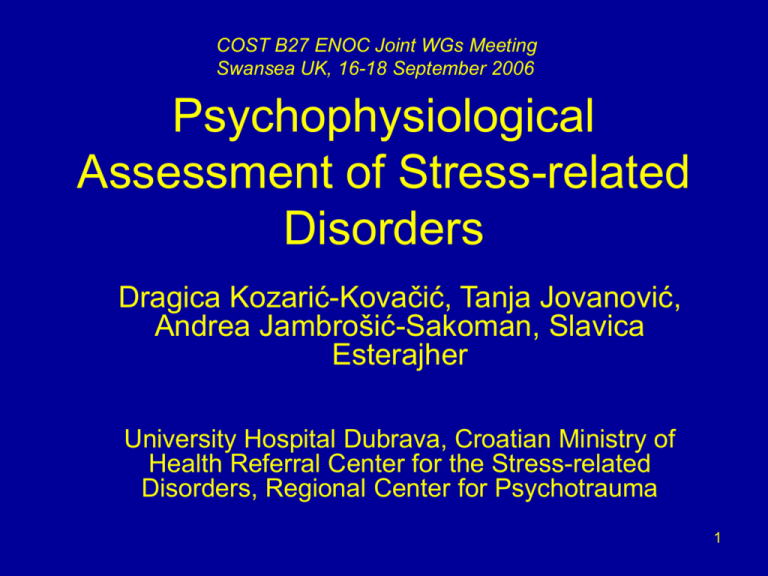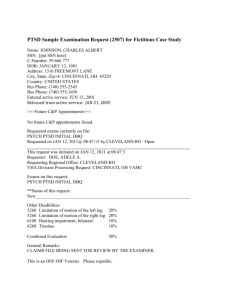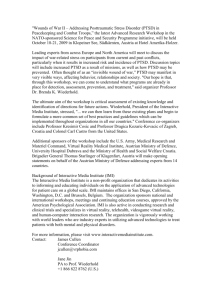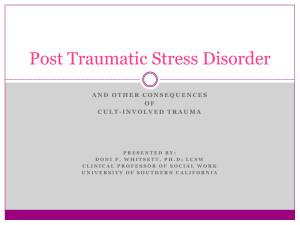Jovanovic T
advertisement

COST B27 ENOC Joint WGs Meeting Swansea UK, 16-18 September 2006 Psychophysiological Assessment of Stress-related Disorders Dragica Kozarić-Kovačić, Tanja Jovanović, Andrea Jambrošić-Sakoman, Slavica Esterajher University Hospital Dubrava, Croatian Ministry of Health Referral Center for the Stress-related Disorders, Regional Center for Psychotrauma 1 Why measure psychophysiology? 2 Rationale • Posttraumatic stress disorder (PTSD) and acute stress disorder (ASD) can develop after exposure to traumatic events • Due to the fact that the diagnosis is based on the patients' self-report of symptoms, a diagnosis of PTSD is difficult to make with certainty, and can be malingered • There is a need to include more objective assessment techniques in a multimodal approach 3 • The psychophysiological reaction to stressful stimuli is under the control of the sympathetic nervous system and is difficult to malinger • In ASD and PTSD reminders of the traumatic experience induce exaggerated fear and subsequent physiological symptoms. 4 Psychophysiology of fear From Lang, Davis & Öhman (2000), J. Affective Disorders 5 Aims of the project • To see whether PTSD patients have increased psychophysiological arousal to trauma stimuli compared to controls • To see whether psychophysiological response in ASD will be related to the development of PTSD • To see whether a lack of association between arousal and PTSD symptoms will be correlated with malingering 6 Baseline psychophysiology 7 Methods • Participants: – 15 male subjects with chronic PTSD • (age=39.5±4.7 years) – 12 male healthy control subjects • (age=41.3±10.7 years) • Trials: – ACL: 3 minutes acclimation period—no stimuli – NA: 7 startle probes, 108 dB [A] SPL, 40ms white noise burst 8 Psychophysiology measures • EDA from fingers for skin conductance response (SCR) 9 • EMG of the obicularis oculi for startle 10 • EKG for heart-rate and respiration for RSA 11 Apparatus • Acquisition: Biopac MP150 for Windows (Biopac Systems, Inc.) • Stimulus presentation: SuperLab 3.0 (Cedrus, Inc.) 12 13 Results: EDA 14 EDA: Higher SCR to startle probes in both groups, controls habituate SCR (MICROSIEMENS) CONTROL PTSD 1.6 1.4 1.2 1 0.8 0.6 0.4 0.2 0 ACL1 ACL2 ACL3 ACL4 ACL5 NA1 NA2 NA3 NA4 NA5 NA6 NA7 TRIALS NA1 VS. ACL5, controls, F(1,11)=17.09, p<0.01; PTSD, F(1,14)=10.40, p<0.01 15 NA1 TO NA7, controls, linear F(1,11)=11.67, p<0.01; PTSD, linear F(1,14)=2.44, ns Results: EMG 16 EMG: no group differences in startle, no habituation CONTROL PTSD STARTLE (MICROVOLTS) 40 35 30 25 20 15 10 5 0 ACL1 ACL2 ACL3 ACL4 ACL5 NA1 NA2 NA3 NA4 NA5 NA6 NA7 TRIALS NA1 VS. ACL5, controls, F(1,11)=5.01, p<0.05; PTSD, F(1,14)=9.50, p<0.01 NA1 TO NA7, controls, linear F(1,11)=2.02, ns; PTSD, linear F(1,14)=1.42, ns 17 Results: EKG 18 EKG: PTSD higher heart-rate than controls, no effect of startle probes CONTROL PTSD HEART RATE (BPM) 100 95 90 85 80 75 70 65 60 ACL1 ACL2 ACL3 ACL4 ACL5 NA1 NA2 NA3 NA4 NA5 NA6 NA7 TRIALS CONTROLS VS. PTSD, F(1,25)=7.56, p=0.01 19 RSA: PTSD lower HR variability than controls, no effect of probes CONTROL PTSD 7.00 6.00 5.00 4.00 3.00 2.00 1.00 0.00 ACL1 ACL2 ACL3 ACL4 ACL5 NA1 NA2 NA3 NA4 NA5 NA6 NA7 TRIALS 20 CONTROLS VS. PTSD, F(1,25)=7.56, p=0.01 Thank you for your attention! 21







